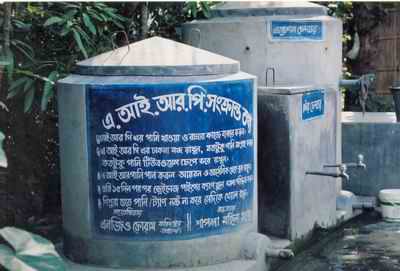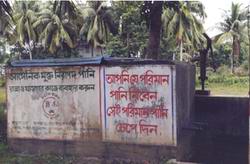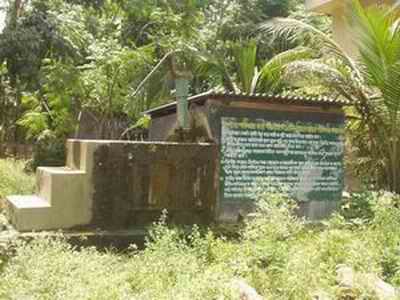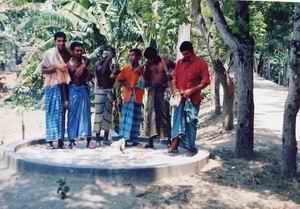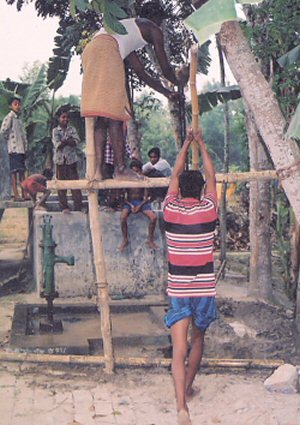The power elites and politicsThe world has now over 6 billion people. Of them, about 3 billion live in poverty and more than one billion of them live in extreme poverty. The majority poor people live in four regions including: South Asia, Africa, Eastern Europe and Central Asia, Latin America and the Caribbean. South Asia and Sub-Saharan Africa are the homes of millions of poor and most of them are extreme poor.
As much as 24 percent of global diseases is caused by environmental exposures, much of which can be averted by well-targeted interventions, the World Health Organization (WHO) said in a report made public recently. The report also estimates that more than 33 percent of diseases in children under the age of 5 is caused by the environmental exposures. And preventing the environmental risks could save as many as four million lives a year in children alone, mostly in the developing countries like Bangladesh. The report titled "Preventing disease through healthy environments -- towards an estimate of the environmental burden of disease" assesses that more than 13 million deaths occur annually due to absence of preventable environmental causes. Of the global figure (13 million), nearly one-thirds of death and disease in the least developed regions occur due to environmental causes.
The tropical and subtropical regions are rich in natural and bio-resources. It implies that poor and marginal group of people in the planet have developed an interdependency relation with nature, where nature and ecosystems give the poor subsistence with food, fiber, water, medicine and fodder. The nature generates various livelihood support services for people for long time while the poor protects and conserve the nature. However, it is also blamed that poor also degrade nature, but they harm the nature for their mere subsistence only. But most cases the commercial interests of the rich backed by the power elites and politics enhance this process of over exploitation (The projects by the World Bank and developing partners benefit only the elites).
The poor donot have adequate access to the available sources of drinking water and they have to suffer the most from lack of safe drinking water resulting in various water related diseases and ill-health.
The urbanisation process is not successful and will pose ecological challenge. The cities are littered with slums, living conditions are terrible and pollution is so high that they pose open risks. The rich for skewing the ideals of globalisation, which he sees as a force but not sufficient enough to fight poverty. blames the rich for skewing the ideals of globalisation, which he sees as a force but not sufficient enough to fight poverty.
Once the rich gave 0.8 per cent of their GNP in assistance which totalled $175 billion. Now, they give only $15 billion and with the gap, we could get schools, immunisation, AIDS prevention and water and sanitation for all the poor of the world. Globalisation is not a sufficient force when the poor countries face disease and poverty with no money. The rich also fall far short of giving access to trade to the poor. Now, the rich can blame the poor for corruption and mismanagement, and the poor can also blame the rich.
The rich nations take the whole year for preparation, but the poor countries do not do their homework and lack a coherent voice. If countries like Brazil, Bangladesh, India which have over a billion in population raise their voice in unison, the rich will have to listen to them. We need a social change in our own country and also in the North.Mitigation 2006
(Left) World Vision failed to supply arsenic free water at Vashan Char or everywhere in faridpur District,but we set (2006) arsenic free well.
Deep tube well at Tambulkhana, Faridpur As 120µg/l and saline (rejected water), we put an arsenic free well a fraction of the cost of the LGRD MinistryMore than 90 percent of the people of Bangladesh are drinking groundwater but this water was always called the “Devil’s Water” by villagers and when tubewells were sunk in many districts, villagers left their villages crying out “the Devil’s Water” is coming, the “Devil’s Water” is coming. But this was quickly brushed aside as superstition. But today people ask - was it just superstition – because hundreds of thousands of people are now suffering from arsenicosis.
Today with an estimated 12-million tubewells in Bangladesh alone, many of which have levels of arsenic in the water above the World Health Organisation’s Safe Guideline recommendations, many people, even today, are drinking poisoned water, often because of ignorance, or apathy but also because they have no alternative. But with no known cure and the best treatment on offer – to drink arsenic-free water and eat a good nutritional diet – this for millions of villagers are still out of reach. We subsequently had to spend millions of dollars for testing tubewells for arsenic – which was a waste of money and time because these kits proved to be useless. Even the World Health Organisation and UNICEF no longer use them.
But the worst seems to be in the Ganga Plain where the population of about 500-million risk their lives by drinking contaminated water. Although that does not mean that all will suffer, or all will continue to drink the water, but they are at risk. The problem is that even after more than fifteen years we are still in the dark and do not know just how big the problem really is. Meanwhile people fall sick and die.
Source: The Bangladesh Observer, June 11, 2006Countless editorials and reports have been published on arsenic contamination but we all know that as far as concrete results are concerned, our achievements have not been overwhelming. In fact, a recent report bares all the facts before us and we know that in the last three years 36 persons have died, 38,500 are affected and about 7 crore people face a direct threat. So far, around 50 lakh tube-wells have been checked and of them, 14 lakh, a staggering number, have been identified to contain arsenic. Already, arsenic contamination has taken a deadly form in 9 thousand villages with 80 to 100 per cent contamination and if the present move aimed at mitigation is not geared up then arsenic will continue to kill and deform(New Age, 19. 05. 06). Mon, 8 May 2006, LGRD and Cooperatives Minister Abdul Mannan Bhuiyan on Monday said care and conservation of water is a matter of national security and that access to safe drinking water is essential for survival. The LGRD Minister said the government has formulated National Water Management Plan to ensure proper use of water.
ARSENIC risk has fast spread over the country in last few years. The current risk has spread over 80 million people. LGRD Minister Abdul Mannan Bhuiya last Sunday informed the national parliament about the matter (Mon, 14 Jun 2004). In the mid-90s it was 50 million and now even before the passage of a decade it has affected 60 per cent people of the whole country. The minister, however, did not say in how many years the number has risen to 80 million from 50. He is, of course, optimistic about the situation when he says," the risk was not alarming". The government is responsive to the situation, no doubt. It has approved a plan regarding arsenic contamination called, "Bangladesh Arsenic Policy 2004". It has approved another plan called, "Arsenic Mitigation Plan." Though the minister has not mentioned any point or points of the arsenic policy and the plan but he briefly mentioned about the steps taken by the government. The steps of the government include training up doctors and supply of safe drinking water to the people of the affected areas.
He said that as many as 14 ongoing projects were under implementation in the arsenic affected areas across the country to address the threats. These projects include the GoB-4 Project under the Public Health Engineering Directorate, the GoB-UNICEF Project, Bangladesh Arsenic Mitigation Water Supply Project and DANIDA Water Supply Project. The Minister said, the government had approved the "Bangladesh Arsenic Policy 2004" and the " (Arsenic) Mitigation Plan". These measures will help solve the problem easily in a coordinated manner. Safe drinking waters is being supplied to people of the affected areas in the country on the basis of these policies, he added. LGRD and Cooperatives Minister Abdul Mannan Bhuiyan on Monday said care and conservation of water is a matter of national security and that access to safe drinking water is essential for survival.
Repeated appeals by local people for safe drinking water have fallen on deaf ears. The administration claims arsenic contamination has been reduced to a large extent but this is evidently wrong.
We invited LGRD Minister to visit arsenic prone areas of Faridpur (March 2006). First, he promised to visit the area but he has more important works to do! He refused to visit project area .
MORE WORDS, LESS WORK ON ARSENIC MITIGATION
LOCAL Government, Rural Development (LGRD) and Co-operatives Minister Abdul Mannan Bhuiyan was commendably candid about words surpassing deeds in terms of mitigating the arsenic challenge. He recognised failures "in providing proper treatment to victims of arsenic contamination" and concluded that there had been "more words on the arsenic problem than action". Such a portrayal of real picture, one hopes, will be followed up by sustained activism in the arsenic mitigation area. We don't want to see such an assessment go in vain or give rise to further talking into the ether.This view was reported on (The Daily Star,) October 16, 2002. But still it is MORE WORDS, LESS WORK ON ARSENIC MITIGATION (2006).
Dr Saadat Hussain (advisor to Advocacy and Human Rights Unit of Brac) identified nepotism at the local governance level and leakage at the service delivery system as major setbacks in developing the status of the ultra-poor. There are some people having close connections with the local government representatives who eat up the relief or other assistance allocated for the ultra-poor under different government programme, he added. "This is how the ultra-poor have been deprived of their access development," he said ((Daily Star, July 13, 2006).
The country had to incur a total financial loss of Tk 526.27 crore due to corruption in various constituents of the public and private sectors in 2005, according to a report on corruption released on Wednesday (5. 07. 06) by Transparency International Bangladesh. Abuse of absolute power helps expansion of corruption in the society,’ said TIB, terming it the main factor behind corrupt practices. According to the report, LGRD and cooperatives ministry is at the top of the list of corruption with incurring over Tk 208 crore losses in 2005. TIB identified the local government, rural development, power division and the forest department as the most corrupt public offices in terms of monetary losses (New Age, July 6, 2006).
What may we know of the secret sorrow of the poor?
The poor in the developing world pay on average 12 times more for water than people connected to municipal systems, according to an ongoing study by the World Commission on Water for the 21st Century. While the rich benefit from subsidized treated piped water, water vendors charge the poor up to 100 times more for water of doubtful quality in some cities such as Port-au-Prince, Haiti and Nouakchot, Mauritania. We know from econometric analysis, that the poorest suffer the most from arsenicosis in Bangladesh (WHO, 2000). Most arsenic patient of Bangladesh is still drinking arsenic contaminated water and can hardly afford any medical treatment or piped water.
The poorest can barely afford to offer money or time for a village committee or maintenance of installations. Therefore, local communities allow each of the families that are making use of the water resource to contribute an amount they can afford. Sometimes, contribution from 30 families for a deep tubewell of Tk. 5000 varies between Tk. 0 and Tk. 800 or piped water. Relatively well-off people who can afford to contribute a large amount of money or to become a member of a village committee, are able to derive more privileges from their increased status.
Despite the quite impressive network of DPHE thana, district and division offices, these departments are hopelessly subject to inefficiency, bureaucracy, corruption, lack of capacity, lack of capabilities, lack of professionals etc.The WB functions best in countries like ours because we have no performance audits, no accountability, extreme crony corruption and, to be honest, inadequate mental faculties to challenge them. Those who have chase them for assignments. And so everyone has a stake in the World Bank.. What became obvious was the extreme contempt in which the official technocrats and bureaucrats held ordinary people. The entire idea of development in Bangladesh is based on the GO-NGO co-operation model and the people have little role to play in this. NGOs are generically fund seekers and now provider of employment. Most of them have almost no reality beyond this. And this generally grovelling bunch conveniently represents the public face in the eyes of the donors who ultimately decide policies. Not because they want to but because they have to. The ability of the national counterparts is so low that they would not be able to formulate a policy without donor support. They are unable to disagree either because that might mean fund cuts. So it all ends up in the same basket (Afsan Chowdhury, Daily Star, famous columnist).
Top of page
Back to Project Report 2003
Women's Project
Home
